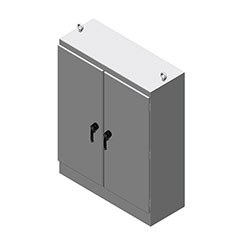Industrial enclosures are used to protect sensitive equipment indoors and outdoors in nonhazardous locations. You may require an industrial enclosure if you are extending your IT network into warehouses and other facilities where environmental conditions must be considered. In this tech tip video, Chatsworth Products (CPI) expert and product marketing manager, Sam Rodriguez, demonstrates how to convert a UL® Type 4 enclosure into a UL Type 3R.
Selecting an enclosure for your specific application needs is critical to protecting your sensitive equipment. CPI offers UL Type 4 and Type 12 enclosures, which are verified by UL through a series of design review and performance testing.

Type 4 enclosures are used in many applications where:
- An occasional washdown occurs
- Coolants may be used nearby
- A pressurized stream of water may be used
Type 4 enclosures are gasketed and the door is clamped for maximum sealing. These enclosures are considered watertight.
Type 3R enclosures are typically used in outdoor applications. This style of enclosure provides protection against:
- Falling rain, sleet, snow, and external ice formation
- Indoors they protect against splashing or dripping water
This style of enclosure may have openings for venting or cable entry and water may enter in small amounts but can’t impact the equipment inside. This enclosure is considered rain-tight.
At times, depending on the location of the Type 4 enclosure, liquids may find their way into the enclosure. For example, during its lifetime, an enclosure’s seal may become damaged. If the seal is damaged, water or other liquids may enter the enclosure. Another example is pressurized liquids entering the enclosure through vent openings during stormy conditions or due to proximity to irrigation systems. In either case, liquids may accumulate inside the sealed enclosure and eventually reach and damage the installed equipment. In these types of applications, steps should be taken to allow liquids to drain. For these applications, a method to drain is added to a tightly sealed enclosure creating a slightly different type of enclosure known as Type 3R.
There may be other application needs that require converting your enclosure for optimal drainage. You can contact CPI technical support or easily order your enclosure using the CPI Product Designer tool.
Brittany Mangan, Digital Content Specialist